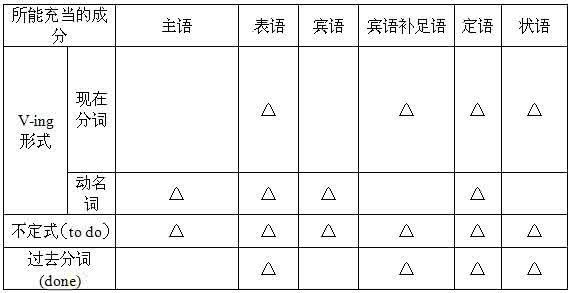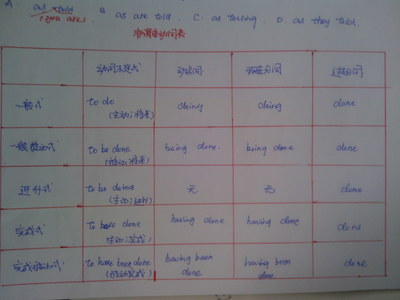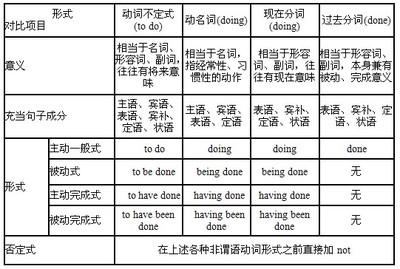非谓语动词用法概要
非谓语动词指动词不定式、Ving 和Ved形式。
请看下表(以动词do为例):
一.非谓语动词基本形式
主 动 被 动
一般式 完成式 一般式 完成式
不定式to do to have done to be done to have been done Ving形式doing having done being done having been done
Ved形式× × done ×
二.非谓语动词均不能在句中单独作谓语,但可以作句子的其他成分。 请看下表:
非谓语动词 主语 宾语 宾补 定语 状语
不定式 √ √ √ √ √
Ving形式 √ √ √ √ √
Ved形式 × × √ √ √
三.非谓语动词具体在句中用法
(一)作主语时
1.不定式作主语表示一个未来的、具体的动作。
To readize your aim is not easy if you don't work hard.
假如你不努力工作,实现目标是不易的。
2.动名词做主语表示一般的、经常性的动作。
1
Speaking English is very important for English study,so to speak English every day is necessary.
英语口语对英语学习是非常重要的,因此有必要每天都练一练英语口语。 I like swimming but I don't like to swim today.
我(平时)喜欢游泳,可是今天不想去游泳。
(二)作宾语时(和作主语是含义类似)
1.下列动词和短语后面只能接不定式:
agree, ask, arrange, choose, determine, dare, agree, demand, expect,elect, fail, hope, long, manage, offer, plan, promise, pretend, refuse, seem, want, wish, should / would like / love
2.下列动词和短语后面只能接Ving形式
admit, avoid, delay, enjoy, escape, excuse, finish, imagine, keep(on), mind, miss, practise, suggest, be / become / get used to, be worth, devote oneself to, feel like, get down to, give up, insist on, look forward to, prefer...to...,put off, etc.
3.下列动词和短语后面接不定式或Ving形式都可以,但是意义有所不同: forget, go on, mean, remember, regret, stop, try, etc.
4.need, require, want三个动词都有相同的意思,也有两种相同的用法—— 主语是动作的承受者时,宾语可以是Ving形式,也可以是不定式的被动式。如:
The house needs / wants / requires ① repairing.
②to be repaired.
2
(三)作宾补时
1.不定式作宾补时,强调动作的全过程。像feel, see, look at, notice, observe, watch, listen to, hear等表示感觉、感官的动词(短语)和have, let,make 等“使役动词” 后面接不带to 的不定式。但上述这类结构变成被动语态时,to一定不能省略。
I heard him sing two foreign songs.
我听见他唱了两首外国歌曲。
Paul doesn't have to be made to study. He always works hard.
Paul一贯学习努力,所以他没有必要被迫去学习
2.V-ing形式作宾补时,强调动作的主动、正在进行。
I heard him singing two foreign songs.
我听见他在唱两首外国歌曲。
3.V-ed形式作宾补时,强调动作的被动、完成。
I heard two foreign songs sung (by him).
He was disappointed to find his suggestion turned down.
当他发现自己的建议被拒绝时,他感到失望。
(四)作定语时
1.不定式作定语通常表示未发生的、带情态意义的或已完成的动作。如:
(1) Who is the woman to teach us geography next year?
=Who is the woman that will teach us geography next year?
(2) Jenny is the proper person to do the job well.
=Jenny is the proper person that can do the job well.
3
(3) The first people to settle in America were from Europe.
=The first people that settled in America were from Europe.
2.动名词作定语表示它所修饰的名词的用途。如:
a swimming pool = a pool for swimming 游泳池
a dining car = a car for dining 餐车
而现在分词作定语表示它所修饰的名词正在进行的、主动的动作。如: a sleeping child = a child who is sleeping 一个正在睡觉的小孩 a woman reading over there
= a woman that is reading over there
一位正在那边读书的妇女
3.V-ed作定语表示一个被动的、完成的动作。如:
the films developed yesterday 昨天(被)冲的胶卷
a developed country 一个发达的(发展过了的)国家
(五)作状语时
1.不定式常作目的和结果状语,而且多出现在in order to... , so as to..., so...as to..., too...to..., ...enough to ...等结构中。如:
She worked hard so as not to fail in the exam.
He is so strong as to lift a heavy box very easily.
I got up early enough to catch the 6∶50 train.
2.V-ing形式和Ved形式常作时间、原因、条件、方式和伴随状语。 作时间、原因、条件状语时,可以改写成相应的状语从句;作方式和伴随状语时,相当于一个并列谓语。如:
4
(1) Given more attention, the trees could have grown better.
= If the trees had been given more attention, they could have grown better.
(2) The students entered the lecture hall, following their teacher.
= The students followed their teacher and entered the lecture hall.
能力·思维·方法
【例1】 Having a trip abroad is certainly good for the old
couple, but it remains whether they will enjoy it.
A. to see B. to be seen C. seeing D. seen
【解析】remains 前面的it 是形式主语,whether 引导的从句是
主语从句,是真正的主语。 remain后接to do sth. 作表语;因要填入的see与whether 引导的主语从句存在动宾关系,也就是主被动关系,所以要用to be seen作remains的表语。答案:B。
【例2】 The research is so designed that once_____ nothing can be done to change it.
A. begins B. having begun C. beginning D. begun
【解析】begin可以是不及物动词,意思是“开始”;也可以是及
物动词,意思是“着手”。本题要表达的句意是:“这项研究计划设计得那么好,一旦着手研究,就没有什么地方要更改的了。” once
begun 是 once it is begun 的省略。答案:D。
【例3】From his_____ look on his face, the price of meat____ .[1996全国统考题]
A. disappointed; has been raised
5
B. disappointed; has been risen
C. disappointing; has raised
D. disappointing; has been risen
【解析】他的脸上表情反映出他被动的、“感到失望”的心态,所以应该用disappointed,而不是disappointing表“令人失望的”。raise 为及物动词, rise 为不及物动词,has been raised=has risen 。答案:A。
【例4】 When I got back home, I saw a message pinned to the door_______ “ Sorry to miss you; will call later.” [1999全国统考题]
A.read B. reads C. to read D. reading
【解析】本题考查V-ing 形式作定语,reading 相当于定语从句
“which read...(内容读来如下……)”,修饰说明先行词message,而不是修饰door。这句话的意思是:“当我回到家的时候,我看到一封短信用别针别在门上。短信内容读来如下:很遗憾没见到你;
以后再来拜访你。”答案:D。
【例5】 The visiting Minister expressed his satisfaction with the talk, ______that he had enjoyed his stay here.
A. having added B. added
C. adding D. to add
【解析】adding在句中作伴随状语,相当于一个并列谓语,其逻辑
主语是句子的主语,且二者之间是主动关系。这句话的意思是:“来访的部长对于会谈表示满意,随后又补充说他在此逗留期间很开心。” 答案:C。
【例6】_____ in thought, he almost ran into the car in front of him. 6
A. Losing B. Having lost C. Lost D. To lose
【解析】从句意可以看出,要填入的词与in thought一起作原因状语,相当于原因状语从句“Because he was lost in thought。”be lost in thought的意思是“陷入沉思”答案:C。
【例7】 The patient was warned ______oily food after the operation.
A. to eat not B. eating not
C. not to eat D. not eating
【解析】warn sb. (not, never) to do sth.的意思是“告诫某人(不 / 决不)要做某事”。注意:不定式的否定结构应把not 放在to do的前面。答案:C。
【例8】 I can hardly imagine Peter______across the Atlantic Ocean in five days.
A. sail B. to sail C. sailing D. to have sailed
【解析】imagine 后面只能接Ving形式作宾语,不能接不定式以
及由不定式构成的复合宾语。题中Peter是sailing的逻辑主语, 构成Ving形式的复合结构,作imagine的宾语。答案:C。
【例9】 Don't use words, expressions or phrases______ only to people with special knowledge.
A. being known B. having known
C. to be known D. known
【解析】know与words, expressions or phrases是动宾关系,要用过去分词作定语,表示被动。这句话的意思是:“不要使用只有具有专业知识的人才能知道的词语。” 答案:D。
7

【例10】______ to sunlight for too much time will do harm to one's skin.
A. Exposed B. Having exposed
C. Being exposed D. After being exposed
【解析】本句中will do 是谓语,缺少主语,因此要选用动名词(
短语)来充当主语。expose与one's skin 之间是动宾关系,因而要用动名词的被动式beingexposed。这句话的意思是:“在阳光下晒太长时间对人的皮肤有害。” 答案:C。
【例11】 In order to gain a bigger share in the international market, many staterun companies are striving ______their products more competitive.
A. to make B. making
C. to have made D. having made
【解析】“strive to do sth.”的意思是“努力做某事”,句中需要填入动词不定式作目的状语。整句话的意思是:“为了在国际市场上取得更大的营业额,许多国有公司正努力使自己的产品具有竞争力。” 答案:A。
8
百度搜索“爱华网”,专业资料,生活学习,尽在爱华网
 爱华网
爱华网



